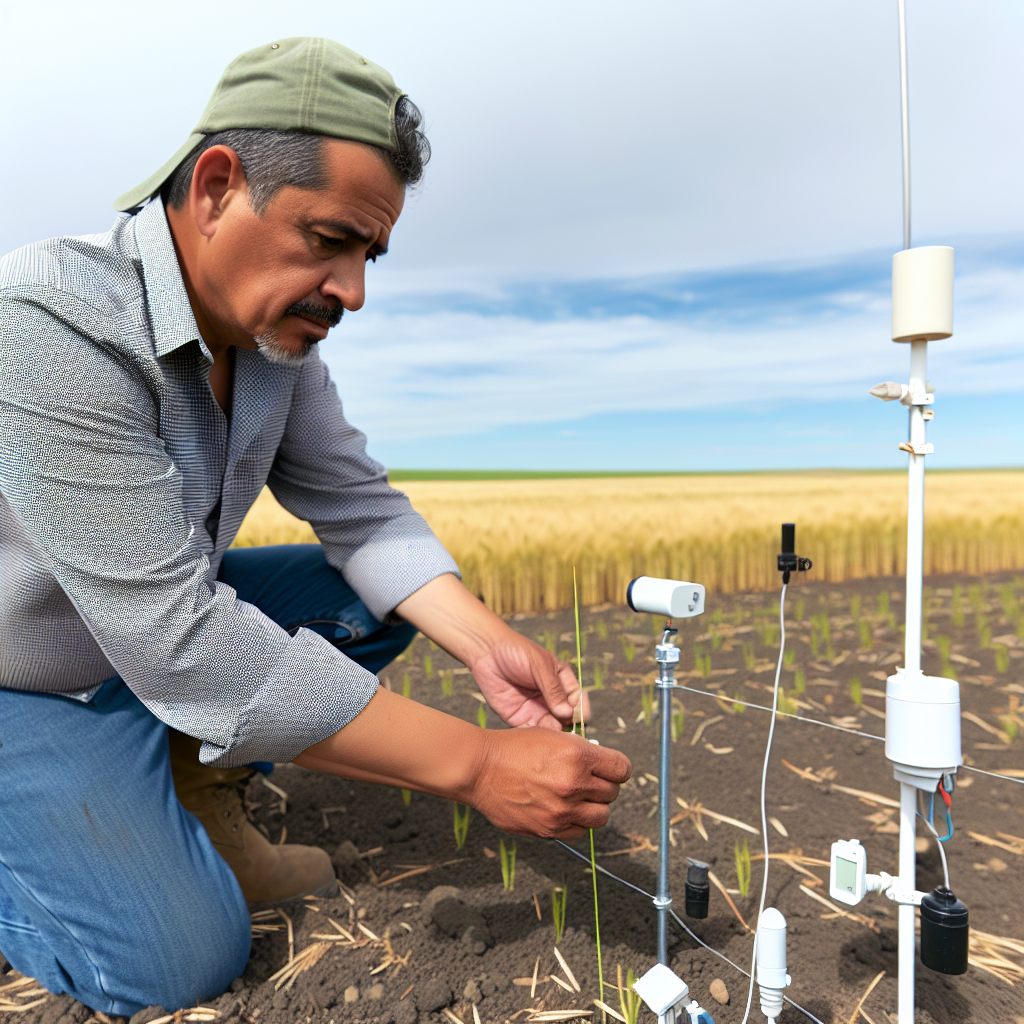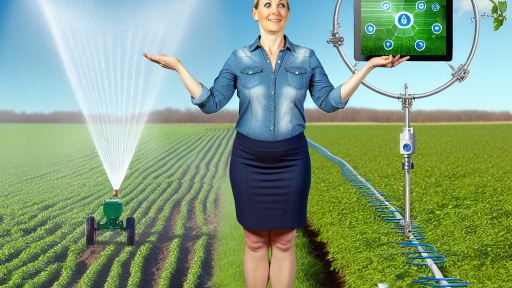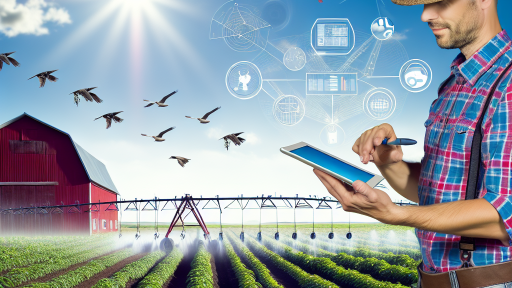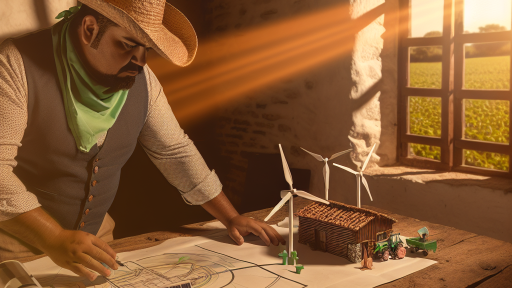Introduction to Sensor Technology in Agriculture
Sensor technology plays a pivotal role in modern agriculture.
Farmers increasingly rely on sensors to improve crop management and productivity.
This technology offers real-time data to enhance decision-making processes.
Moreover, it helps optimize resource utilization, reducing waste significantly.
Various types of sensors exist, each serving unique agricultural needs.
Types of Sensors in Agriculture
Sensors come in different categories tailored for specific applications.
Soil moisture sensors monitor soil conditions to determine irrigation requirements.
Weather sensors collect data on climatic conditions affecting crop growth.
Similarly, crop health sensors analyze plant health and detect diseases early.
Furthermore, livestock monitoring sensors track animal health and behavior.
Benefits of Utilizing Sensor Technology
One significant advantage is improved efficiency in farming operations.
Sensors facilitate precision agriculture, leading to better yields.
Additionally, they contribute to sustainable farming practices by minimizing environmental impact.
Data from sensors can lead to informed decisions, resulting in cost savings.
Ultimately, these benefits contribute to enhanced food security globally.
Transform Your Agribusiness
Unlock your farm's potential with expert advice tailored to your needs. Get actionable steps that drive real results.
Get StartedThe Economic Impact of Sensor Solutions
The use of sensors can lead to significant financial savings for farmers.
Initial investment in sensor technology is often offset by long-term gains.
Farmers experience lower operational costs due to optimized resource management.
Moreover, data-driven insights help maximize crop yields and profitability.
In this way, sensor technology fosters economic growth in the agricultural sector.
Overview of Cost-Effective Sensor Types
Soil Moisture Sensors
Soil moisture sensors measure the water content in the soil.
They help farmers optimize irrigation practices.
Additionally, these sensors can prevent overwatering.
Proper moisture levels lead to healthier crops and lower costs.
Several types are available, including resistive and capacitive sensors.
Resistive sensors are cost-effective and easy to use.
Capacitive sensors offer better accuracy and durability.
Temperature Sensors
Temperature sensors monitor the ambient and soil temperatures.
They provide crucial data for crop management decisions.
Farmers can adjust planting schedules based on temperature readings.
These sensors can ensure optimal conditions for crop growth.
Common types include thermocouples and thermistors.
Thermocouples are suitable for high-temperature applications.
Thermistors are more accurate for lower temperature ranges.
pH Sensors
pH sensors measure the acidity or alkalinity of soil.
They play a critical role in soil health assessment.
A proper pH balance promotes nutrient availability for plants.
Farmers can amend soils based on sensor readings for improvement.
There are portable and stationary pH sensors available.
Showcase Your Farming Business
Publish your professional farming services profile on our blog for a one-time fee of $200 and reach a dedicated audience of farmers and agribusiness owners.
Publish Your ProfilePortable sensors allow for field testing and immediate results.
Stationary sensors are useful for ongoing monitoring.
Benefits of Using Sensors for Precision Agriculture
Enhancing Crop Monitoring
Sensors significantly improve crop monitoring processes.
They provide real-time data on soil moisture levels.
Consequently, farmers can make informed irrigation decisions.
This technology targets specific areas requiring water.
As a result, it optimizes water usage and supports healthy crops.
Increasing Yields
Using sensors consistently boosts crop yields.
By analyzing plant health data, farmers can apply precise treatments.
For example, they can detect nutrient deficiencies early.
Thus, timely interventions ensure optimal growth conditions.
Furthermore, healthier plants lead to higher harvests.
Reducing Costs
Sensors help in cutting down operational costs significantly.
Farmers can minimize the use of fertilizers and pesticides.
They apply these inputs only where necessary.
This targeted approach not only saves money but also protects the environment.
Additionally, less waste contributes to more sustainable farming.
Boosting Efficiency
Implementing sensor technology enhances overall farm efficiency.
Automated systems can monitor conditions continuously.
This allows farmers to focus on strategic decisions.
Additionally, data analytics can improve resource allocation.
Consequently, time and labor resources are used more effectively.
Supporting Sustainable Practices
Sensor solutions promote more sustainable agricultural practices.
They facilitate precision agriculture techniques that reduce environmental impact.
For instance, reduced chemical runoff benefits local ecosystems.
Sensors also help in trackable water usage, promoting conservation.
Therefore, adopting sensors contributes to a healthier planet.
You Might Also Like: Maximizing Profits with Agricultural Data
Comparative Analysis of Traditional Methods vs. Sensor Solutions
Traditional Methods in Agriculture
Traditional agricultural methods have been the norm for centuries.
These methods include guesswork and manual labor for decision-making.
Farmers often rely on historical weather data and personal experience.
Unfortunately, this approach can lead to inefficiencies and missed opportunities.
For instance, crop yields may suffer due to inaccurate assessments.
Additionally, farmers may struggle with resource management.
Consequently, they may overuse water or fertilizers.
These practices can harm the environment and increase costs.
Introduction to Sensor Solutions
Sensor solutions revolutionize agricultural practices today.
They offer real-time data collection and analysis.
Farmers can access valuable information about soil, weather, and crop health.
This technology enhances precision farming techniques significantly.
Showcase Your Farming Business
Publish your professional farming services profile on our blog for a one-time fee of $200 and reach a dedicated audience of farmers and agribusiness owners.
Publish Your ProfileMoreover, sensor solutions can drastically reduce labor costs.
Farmers can monitor multiple fields remotely at any time.
Cost Comparison
Traditional methods often incur high labor and operational costs.
In contrast, sensor technologies require a one-time investment.
Over time, this investment leads to substantial cost savings.
Farmers can allocate resources more effectively with sensors.
This efficiency results in improved crop yields and profitability.
Impact on Crop Management
Traditional methods provide limited insight into crop health.
Farmers often apply inputs uniformly across entire fields.
This practice can lead to resource wastage and uneven crop quality.
Sensor solutions, however, allow for targeted interventions.
Farmers can apply fertilizers and water precisely where needed.
This targeted approach enhances crop management significantly.
Environmental Considerations
The environmental impact of traditional farming can be severe.
Overuse of water and chemicals can degrade soil and water quality.
Conversely, sensor solutions promote sustainable practices.
With real-time data, farmers can minimize their ecological footprint.
They can adhere to best practices without compromising yields.
Integration Challenges
Despite their advantages, sensor technologies face integration challenges.
Farmers must adapt to new technology and data management systems.
This transition can require training and investment in new tools.
However, the long-term benefits often outweigh these initial challenges.
Ultimately, successful integration can transform agricultural efficiency.
Discover More: Maintenance Tips for Agricultural Automated Systems
Integration of Sensors with IoT for Data Collection and Analysis
Enhancing Precision Agriculture
Sensors play a vital role in precision agriculture.
They gather detailed data on soil conditions and crop health.
Farmers can use this information to make informed decisions.
This approach improves yield and reduces resource waste.
Real-Time Data Monitoring
Real-time data monitoring enhances farm management.
Sensors provide continuous information on environmental factors.
For instance, moisture levels directly affect crop growth.
Timely data allows farmers to adjust irrigation efficiently.
Cost-Effective Solutions
Cost-effective sensor solutions are essential for all farmers.
Recent advancements reduce the prices of sensors steadily.
Affordable options enable smaller farms to benefit from data.
Investing in these technologies yields long-term savings.
Data Integration with IoT Platforms
Integrating sensors with IoT platforms maximizes data utility.
Farmers can visualize data through user-friendly dashboards.
This integration simplifies monitoring from any location.
Moreover, alerts can notify farmers of critical changes.
Showcase Your Farming Business
Publish your professional farming services profile on our blog for a one-time fee of $200 and reach a dedicated audience of farmers and agribusiness owners.
Publish Your ProfileImpact on Sustainable Farming Practices
Sensor technology supports sustainable farming practices.
By analyzing data, farmers can optimize inputs and reduce waste.
This leads to more environmentally friendly cultivation methods.
As a result, agriculture becomes more sustainable over time.
Future Trends in Sensor Technology
The future of sensor technology looks promising.
Emerging innovations will further enhance accuracy and efficiency.
For example, the advent of AI integration is on the horizon.
Such technology will refine decision-making processes significantly.
Explore Further: Boost Crop Yields with Precision Agriculture Techniques

Case Studies: Successful Implementation of Cost-Effective Sensors in Farms
Introduction to Sensor Technology in Agriculture
Sensor technology revolutionizes modern agriculture.
These sensors provide real-time data to farmers.
This information drives better decision-making on the farm.
Consequently, productivity and resource management improve dramatically.
Dr. Emily Carter’s Vineyard Success
Dr. Emily Carter operates a vineyard in Sonoma Valley.
She integrated soil moisture sensors into her irrigation system.
This technology helps her monitor soil conditions continuously.
As a result, she optimizes water usage throughout the growing season.
Dr. Carter reports a 30% reduction in water consumption.
She also noticed healthier grapevines and improved crop yield.
The Johnson Family Dairy Farm
The Johnson Family manages a dairy farm in Wisconsin.
They adopted temperature and humidity sensors in their barns.
This setup allows them to maintain optimal conditions for their cows.
Consequently, milk production has increased significantly.
Moreover, fewer cows fall ill during extreme weather conditions.
Veterinary costs have decreased thanks to better animal welfare.
GreenTech Innovations’ Collaboration with Local Farmers
GreenTech Innovations partnered with local farmers in Ohio.
They introduced low-cost environmental sensors across various crops.
Farmers monitor temperature, humidity, and soil pH using mobile apps.
This initiative leads to precise fertilization and irrigation practices.
Farmers reported higher revenues from their freshly optimized yields.
GreenTech’s approach highlights the benefits of sensor data accessibility.
Lessons Learned from Successful Implementation
Cost-effective sensor solutions lead to significant benefits in agriculture.
Farmers gain valuable insights into their operations.
As a result, they can adapt to changing environmental conditions more efficiently.
Improved resource management reduces operational costs.
Furthermore, better crop yields enhance overall profitability.
Ultimately, the adoption of sensor technology empowers farmers.
Learn More: Leveraging Satellite Imagery for Precision Farming
Challenges in Adopting Sensor Technology in Agriculture
High Initial Costs
Implementing sensor technology involves significant startup costs.
Farmers often perceive these costs as a major barrier.
Showcase Your Farming Business
Publish your professional farming services profile on our blog for a one-time fee of $200 and reach a dedicated audience of farmers and agribusiness owners.
Publish Your ProfileThis perception affects their willingness to invest in new solutions.
Research shows that initial investments can be substantial.
However, long-term savings can offset these costs.
Lack of Technical Expertise
Many farmers lack the technical skills required to operate sensors.
This gap in knowledge hinders effective implementation.
Training programs can help bridge this gap.
Moreover, partnerships with tech companies may provide vital support.
Data Overload and Management
Sensors generate large volumes of data.
Managing this data can overwhelm farmers.
Without analysis, the data may offer little value.
Investment in data management solutions is crucial.
Farmers need access to user-friendly analytics tools.
Resistance to Change
Farmers often depend on traditional practices.
This reliance can lead to resistance to adopting new technologies.
Addressing concerns about reliability and effectiveness is essential.
Educating farmers about the benefits of sensors can help.
Uncertain Regulatory Environment
The regulatory landscape for agricultural technology is often unclear.
Farmers may fear compliance challenges with new technologies.
Understanding regulations can help ease these fears.
Engagement with policymakers is vital for clarity.
Connectivity Issues
Reliable connectivity is crucial for sensor functionality.
In rural areas, internet access may be limited.
This limitation can hinder the full potential of sensor technology.
Investing in infrastructure improvements can address this challenge.
Future Trends and Innovations in Agricultural Sensor Technologies
Advancements in Sensor Design
Innovations in sensor design drive efficiency in agriculture.
New materials enhance durability and accuracy.
Also, miniaturization enables more devices in smaller spaces.
Integration of IoT in Farming
The Internet of Things revolutionizes agricultural practices.
Connected sensors allow real-time data collection and analysis.
Farmers can monitor conditions remotely, increasing efficiency.
Data Analytics and Artificial Intelligence
Data analytics transforms raw data into actionable insights.
Artificial intelligence predicts trends and anomalies in crops.
This technology helps farmers make informed decisions quickly.
Remote Sensing Technologies
Remote sensing provides a holistic view of farm health.
Drones and satellites gather data on large areas efficiently.
These tools detect crop stress and soil moisture levels accurately.
Sustainability-focused Innovations
New sensors help reduce waste and increase resource efficiency.
Technologies support sustainable practices in irrigation and fertilization.
Farmers can optimize inputs, thus promoting environmental health.
Affordable Sensors for Smallholder Farmers
Cost-effective sensors democratize technology access for small-scale farmers.
Showcase Your Farming Business
Publish your professional farming services profile on our blog for a one-time fee of $200 and reach a dedicated audience of farmers and agribusiness owners.
Publish Your ProfileAffordable solutions can significantly enhance productivity.
Organizations develop low-cost options tailored to rural settings.
Future Outlook of Agricultural Sensors
Continued research will push boundaries in sensor technologies.
Emerging trends focus on enhancing user-friendliness and integration.
Ultimately, these innovations shape the future of agriculture.
Additional Resources
AI in Agriculture and Farming: Revolutionizing Crop Growth – Intellias
UCF Researchers Lead Project to Develop AI-driven Technologies …




